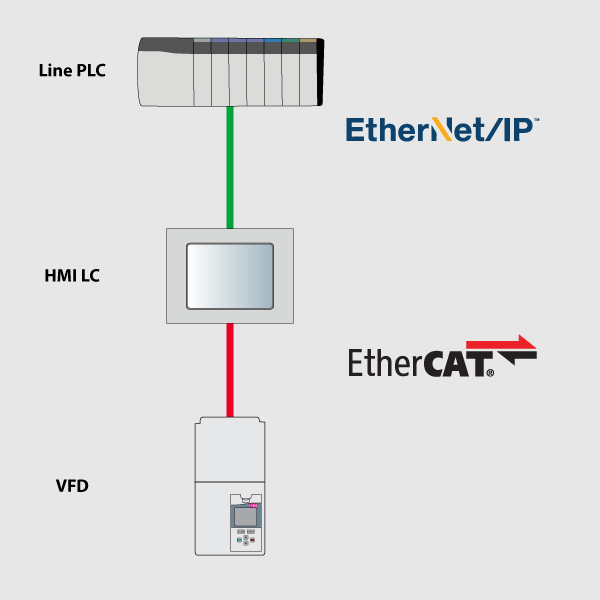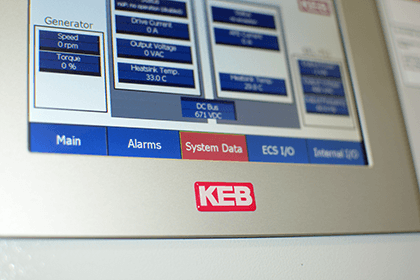Using the HMI LC as an Intelligent Network Gateway
Historically, connecting two different communication networks was handled by a dedicated network gateway. We worked on an application a couple months ago where we were able to implement this gateway functionality in an HMI LC. This is what it looked like.
The customer’s main PLC was an Allen-Bradley communicating with EtherNet/IP (protocol 1). The AB PLC connected to a machine panel that used a KEB HMI LC.

The HMI LC used EtherCAT (protocol 2) to control a 200Hp F6-K EtherCAT VFD.

EtherCAT for the VFD
EtherCAT was chosen because it provides a high-speed CAT5 connection to the drive. Also, programming the drive communication is made easy through the KEB’s EtherCAT communication handler Function Block.
A group of parameters was defined for the EtherCAT process data (PDO). The PDO gives cyclical and high-speed updates on the critical parameters.
Additionally, we implemented the DIN66019 II protocol (protocol #3) which can be used to read/write individual drive parameters. Beyond the fast-channel EtherCAT PDO parameters, this gives the ability to access every KEB drive parameter including fault codes, warnings, etc. It also provides the functionality to do a full upload and download of drive parameters.
The HMI LC can then relay any drive parameter back to the upstream PLC via EtherNet/IP. In short, the HMI LC is acting as a gateway to handle the 3 different communication protocols.

Mix-and-Match other Communication Protocols
This same concept can be extended to the other 40+ protocols supported by the HMI products. This includes Modbus, Profinet, etc. Even serial fieldbus networks Data Highway, DH+, and Profibus are possible.

So why would somebody prefer to implement this solution with the HMI LC instead of a communication gateway? It’s a fair question. The reason is that the HMI LC gives you a lot more flexibility and functionality than the traditional network gateway hardware.
Visualization
It’s obvious but worth highlighting – The HMI LC adds visualization. In this application, it served as a drive remote operator, displaying speed, load, temperature, drive status and error history.

Additionally, it offers the possibility to display PDF manuals, diagnostics, logs, error history, trending information, etc. You won’t get that with a gateway-only device.
Secure Remote Access with CONNECT
Each HMI LC ships with a Combivis CONNECT Runtime. This allows a secure VPN connection to be made to the machine which improves troubleshooting and diagnostic gathering.
Logic Control
The HMI LC offers the possibility to handle the entire machine control including EtherCAT remote I/O. From that standpoint, it becomes a very good value.
Automatic Drive Download
If a replacement drive needs to be installed at some point in the future, the HMI LC can automatically download the correct program. Again, this functionality is made easy with an included KEB Function Block in the Combivis Studio software. This functionality makes long-term support for the machine easier.
Conclusion
With over 40 communication drivers, the HMI LC can act as a gateway between two different networks. But the HMI LC is much more than a gateway. The HMI LC offers a lot of value and is a scalable product that increases a machinery OEM flexibility and maintainability.
If you are interested in more information on the HMI LC contact a KEB engineer today.
Let's Work Together
Connect with us today to learn more about our industrial automation solutions—and how to commission them for your application.





